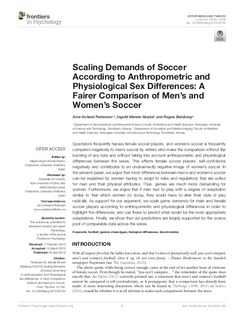| dc.contributor.author | Pedersen, Arve Vorland | |
| dc.contributor.author | Aksdal, Ingvild Merete | |
| dc.contributor.author | Stalsberg, Ragna | |
| dc.date.accessioned | 2019-09-17T07:22:00Z | |
| dc.date.available | 2019-09-17T07:22:00Z | |
| dc.date.created | 2019-04-09T09:24:02Z | |
| dc.date.issued | 2019 | |
| dc.identifier.citation | Frontiers in Psychology. 2019, 10 (762), | nb_NO |
| dc.identifier.issn | 1664-1078 | |
| dc.identifier.uri | http://hdl.handle.net/11250/2617103 | |
| dc.description.abstract | Spectators frequently harass female soccer players, and women’s soccer is frequently compared negatively to men’s soccer by writers who make the comparison without the backing of any data and without taking into account anthropometric and physiological differences between the sexes. This affects female soccer players’ self-confidence negatively and contributes to an undeservedly negative image of women’s soccer. In the present paper, we argue that most differences between men’s and women’s soccer can be explained by women having to adapt to rules and regulations that are suited for men and their physical attributes. Thus, games are much more demanding for women. Furthermore, we argue that if men had to play with a degree of adaptation similar to that which women do today, they would have to alter their style of play radically. As support for our argument, we scale game demands for male and female soccer players according to anthropometric and physiological differences in order to highlight the differences, and use these to predict what would be the most appropriate adaptations. Finally, we show that our predictions are largely supported by the scarce pool of comparable data across the sexes. | nb_NO |
| dc.language.iso | eng | nb_NO |
| dc.publisher | Frontiers Media | nb_NO |
| dc.relation.uri | https://www.frontiersin.org/articles/10.3389/fpsyg.2019.00762/full | |
| dc.rights | Navngivelse 4.0 Internasjonal | * |
| dc.rights.uri | http://creativecommons.org/licenses/by/4.0/deed.no | * |
| dc.title | Scaling Demands of Soccer According to Anthropometric and Physiological Sex Differences: A Fairer Comparison of Men’s and Women’s Soccer | nb_NO |
| dc.type | Journal article | nb_NO |
| dc.type | Peer reviewed | nb_NO |
| dc.description.version | publishedVersion | nb_NO |
| dc.source.volume | 10 | nb_NO |
| dc.source.journal | Frontiers in Psychology | nb_NO |
| dc.source.issue | 762 | nb_NO |
| dc.identifier.doi | https://doi.org/10.3389/fpsyg.2019.00762 | |
| dc.identifier.cristin | 1690992 | |
| dc.description.localcode | Copyright © 2019 Pedersen, Aksdal and Stalsberg. This is an open-access article distributed under the terms of the Creative Commons Attribution License (CC BY). The use, distribution or reproduction in other forums is permitted, provided the original author(s) and the copyright owner(s) are credited and that the original publication in this journal is cited, in accordance with accepted academic practice. No use, distribution or reproduction is permitted which does not comply with these terms. | nb_NO |
| cristin.unitcode | 194,65,30,0 | |
| cristin.unitcode | 194,65,25,0 | |
| cristin.unitname | Institutt for nevromedisin og bevegelsesvitenskap | |
| cristin.unitname | Institutt for sirkulasjon og bildediagnostikk | |
| cristin.ispublished | true | |
| cristin.fulltext | original | |
| cristin.qualitycode | 2 | |

